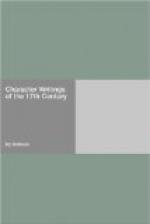Is the next of our Character writers. His “Microcosmography, or a Piece of the World discovered, in Essays and Characters” was first printed in 1628. John Earle was born in the city of York, at the beginning of the seventeenth century, probably in the year 1601. His father, who was Registrar of the Archbishop’s Court, sent him to Oxford in 1619, and he was said to be eighteen years old when he matriculated, that year, as a commoner at Christchurch. He graduated as Master of Arts in 1624. He was a Fellow of Merton, and wrote in his younger days several occasional poems that won credit before he published anonymously, still as an Oxford man, when he was about twenty-seven years old, his famous Characters. But he remembered York when adding to their title that they were “newly composed for the northern part of this Kingdom.” This first edition contained fifty-four characters, which precede the others in the following collection. In the next year, 1629, the book reached a fifth edition, printed for Robert Allot, in which the number of the characters was increased to seventy-six. Two more characters—a Herald, and a Suspicious or Jealous Man—were added in the sixth edition, which was printed for Allot in 1633. The seventh edition was printed for Andrew Coolie in 1638, the eighth in 1650. Other editions followed in 1669, 1676, 1732, and at Salisbury in 1786. In 1811 the little book was edited carefully by Dr. Philip Bliss, and it was edited again by Professor Edward Arber in 1868, in his valuable series of English Reprints.
John Earle, after the production of his “Microcosmography,” wrote in April 1630 a short poem upon the death of William, third Earl of Pembroke, son of Sidney’s sister. The third Earl’s younger brother Philip succeeded as fourth Earl, and was Chancellor of the University of Oxford. He was then, or thereafter became, Earle’s patron, and made him his chaplain. About the same time, in 1631, Earle acted as proctor of the University. In 1639 the Earl of Pembroke presented John Earle to the living of Bishopston in Wiltshire, as successor to Chillingworth. Pembroke being Lord Chamberlain was entitled also to a residence at Court for his chaplain, and thus Earle was brought under the immediate notice of Charles I., who appointed him to be his own chaplain, and made him tutor to Prince Charles in 1641, when Dr. Brian Duppa, the preceding tutor, had been made Bishop of Salisbury. In 1642 Earle proceeded to the degree of D.D. In 1643 he was elected Chancellor of the Cathedral at Salisbury, but he was presently deprived by the Parliament of that office, and of his living at Bishopston. He then lived in retirement abroad, made a translation into Latin of Hooker’s “Ecclesiastical Polity” which his servants negligently used, after his death, as waste paper, and of the “Eikon Basilike” which was published in 1649. After the Restoration, Dr. Earle was made Dean of Westminster; then, in 1662, Bishop of Worcester. He was translated to Salisbury in 1663, died in November 1665, and was buried near the altar in Merton College Church.




